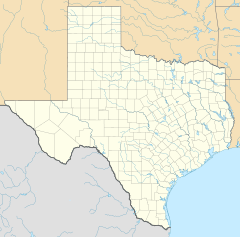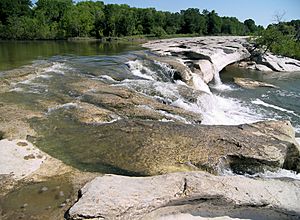McKinney Falls State Park facts for kids
Quick facts for kids McKinney Falls |
|
|---|---|

Lower McKinney Falls
|
|
| Location | Travis County, Texas |
| Nearest city | Austin |
| Area | 744.4 acres (301 ha) |
| Established | 1976 |
| Governing body | Texas Parks and Wildlife Department |
McKinney Falls State Park is a cool place to visit in Austin, Texas. It's where two creeks, Onion Creek and Williamson Creek, meet. The park is managed by the Texas Parks and Wildlife Department. It opened on April 15, 1976. The park is named after Thomas F. McKinney, who owned this land in the 1800s. He was a businessman, horse breeder, and rancher. This park is also part of the historic El Camino Real de los Tejas National Historic Trail.
Contents
Ancient Times at McKinney Falls
How the Falls Were Made
Millions of years ago, a shallow sea covered much of Texas. Over time, tiny sea creatures and shells settled on the bottom. These layers of calcium carbonate turned into limestone rock. You can still see this rock today around the creek.
Ancient sea animals lived here. Scientists found a full skeleton of a mosasaur, a large swimming reptile, in Onion Creek nearby. In the park's limestone, you can find shells of old sea animals like Inoceramus and Exogyra.
A volcano called "Pilot Knob" was active nearby. It shot out soft volcanic ash and rock. Over millions of years, water wore away the softer volcanic layers faster than the hard limestone. This process created the beautiful falls we see today.
Early Human Visitors
People have lived on this land for a very long time. There is proof that hunter-gatherers were here at least 5,000 years ago. They found fresh water in the creeks. They also used the natural rock shelters for protection. These shelters were formed by the same water action that made the falls.
History of the Park Land
The El Camino Real Trail
Long ago, the land that is now McKinney Falls State Park was part of a famous trail. This trail was called the El Camino Real de Los Tejas. In 1716, an explorer named Domingo Ramón traveled along Onion Creek here. You can still see marks in the rock from all the people and animals that used this trail.
Thomas F. McKinney's Ranch
The land for the park was once a huge property. Thomas F. McKinney bought a large part of it in 1839. He moved here in 1850 and built a stone house and barns. In 1852, he built a gristmill that used water power to grind flour. A big flood in 1869 destroyed the mill. His house burned down in the late 1940s. McKinney lived here, raising thoroughbred horses and ranching, until he passed away in 1873.
Becoming a State Park
In 1971, J.E. "Pete" Smith, who was Thomas McKinney's grandson, gave 682 acres of the ranch to Texas. This land was meant to become a state park. The state received money to help develop the park. After checking the land for important historical items, the park was built. It was officially opened on April 15, 1976.
In 2013, heavy rains caused Onion Creek to flood. The water reached its highest level since the park opened. It damaged the visitor center and some trails. The park had to close for a while for cleanup and repairs.
Park Features to Explore
The park has many great things to see and do. You can hike on several trails. The most famous parts of the park are the beautiful upper and lower falls along Onion Creek.
Plants You Might See
Along Onion Creek, you'll find tall Bald Cypress, sycamores, and pecan trees. In the drier areas, there are live oak, ashe juniper, and mesquite trees. Other trees include Wafer Ash, Red Oak, Texas Persimmon, and Cedar Elm.
In the spring, the roads are covered with colorful flowers. The most common is the Texas Bluebonnet. You can also spot different cacti like the Prickly Pear.
Animals You Might Spot
Many animals live in the park. You'll often see White-tailed deer, raccoons, and armadillos. Other animals include coyotes, cottontail rabbits, and Fox squirrels.
Many kinds of birds fly around the park. Look for the Northern mockingbird, Northern cardinal, Greater roadrunner, and Blue jay. Near the creeks, you might see turtles like the Guadalupe spiny softshell turtle and Red-eared slider. Several types of snakes also live here, such as the Texas rat snake and the Western diamondback rattlesnake.
Historical Sites to Visit
The park also has important historical places. The Smith Rock Shelter is a limestone overhang. Native Americans used it for shelter for hundreds of years. You can also see the ruins of Thomas McKinney's stone house, his old gristmill, and his horse trainer's cabin. Both the Smith Rock Shelter and the McKinney homestead are listed on the National Register of Historic Places.
Water Quality and Swimming
Why Swimming Was Banned
McKinney Falls was a popular place for swimming when it first opened. But in 1981, swimming was stopped. Some children got sick after swimming in Onion Creek. Tests showed that the water had too much bacteria from animal waste.
This problem was caused by rain washing pollution from nearby towns into the creeks. Things like animal waste, oil, and dirt flowed into the water. A wastewater treatment plant also sometimes released dirty water into Williamson Creek.
Swimming Returns to the Park
Twelve years later, in 1993, swimming was allowed again. This happened because the wastewater plant closed in 1986. Also, the city of Austin started new programs to keep the creeks clean. They began collecting hazardous chemicals and protecting the water.
Even today, swimming is sometimes restricted. This usually happens after heavy rains. The rain can still wash too much bacteria into the creeks, making the water unsafe for swimming for a short time.




